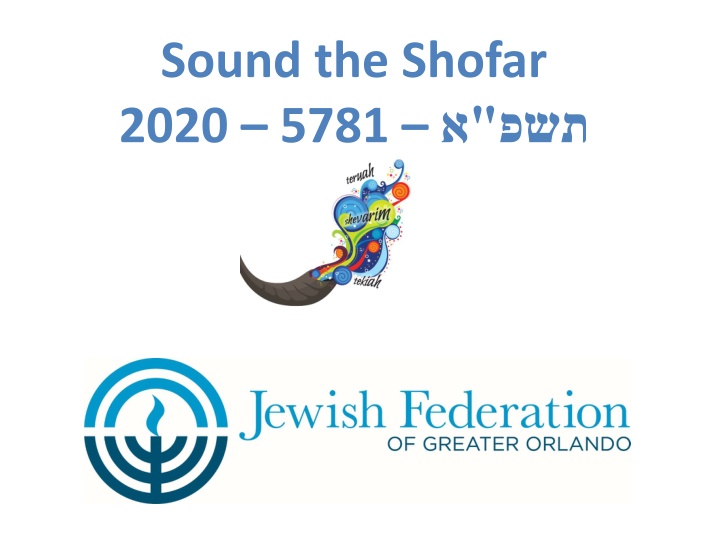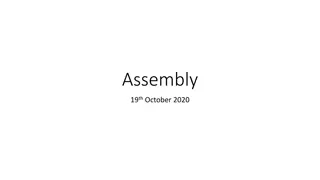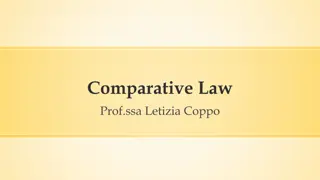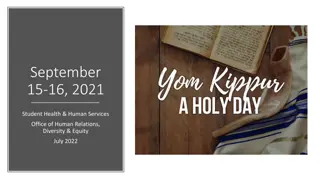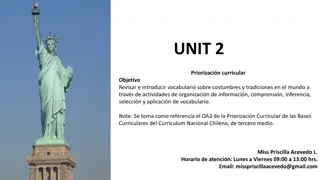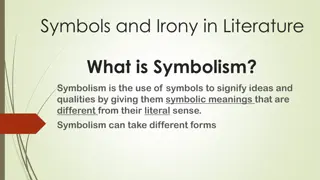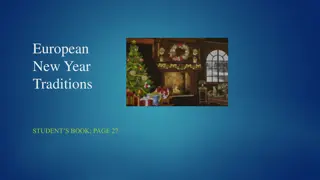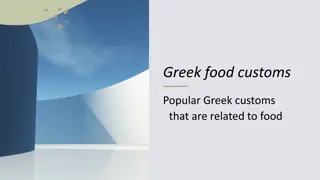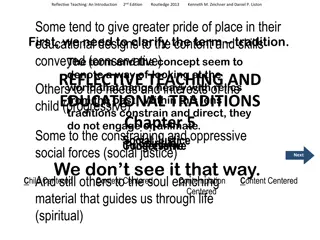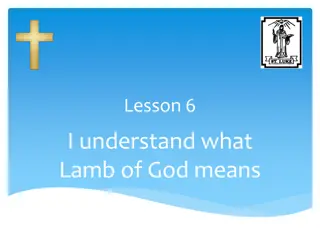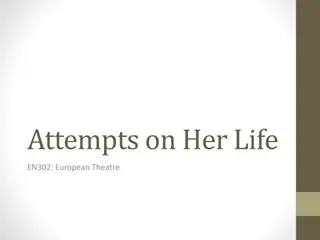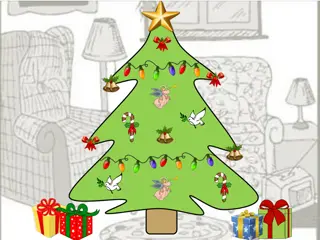All About the Shofar: Symbolism, Types, and Traditions for Rosh Hashanah
Explore the significance of the shofar in Jewish traditions, its various types from different animal horns, and the rituals surrounding its use in Rosh Hashanah and Yom Kippur. Learn about the sounds of the shofar, the timing of when it is sounded, and the historical background of this sacred instrument in Jewish culture.
Download Presentation

Please find below an Image/Link to download the presentation.
The content on the website is provided AS IS for your information and personal use only. It may not be sold, licensed, or shared on other websites without obtaining consent from the author.If you encounter any issues during the download, it is possible that the publisher has removed the file from their server.
You are allowed to download the files provided on this website for personal or commercial use, subject to the condition that they are used lawfully. All files are the property of their respective owners.
The content on the website is provided AS IS for your information and personal use only. It may not be sold, licensed, or shared on other websites without obtaining consent from the author.
E N D
Presentation Transcript
Sound the Shofar 2020 5781 "
Some Examples of Shofars A Dall Sheep with horns. Greater Kudu, Namibia. A shofar made from the horn of a Greater kudu A shofar made from a ram's horn Cross section of an animal's horn. To make a shofar, the bone (cross hatches) and fleshy sheath (white) are removed, leaving the actual horn.
1. Cattle horn shofar (nonkosher), 2. Kudu shofar, 3. Ibex shofar, 4. Aoudad sheep shofar, 5. Water buffalo shofar (questionable if kosher), 6. Partially- straightened ram s horn shofar, 7. Fully-twisted ram s horn shofar, 8. Blackbuck shofar, 9. Pronghorn shofar. Most animal horns are hollow and can theoretically be made into shofarot. (Although some are pasul, disqualified, such as that of a cow.) Horns that are not hollow may not be used as shofarot, even if they are drilled through. Antlers, the branched horns of deer, may therefore not be used as shofarot since they are not hollow. Although the horns of pronghorns superficially resemble deer antlers, they are, in fact, hollow and therefore kosher. However, it is preferable not to use the pronghorn shofar because it is not curved., 10. Gemsbok shofar
Its a Mitzvah! To HEAR the blasts of the shofar
When do we sound the shofar? Daily in the morning during the Hebrew month of Elul (except Shabbat) August 21-September 17, 2020 Rosh Hashanah September 19* & 20, 2020 End of Yom Kippur September 28, 2020 *Traditionally the shofar in not sounded on Shabbat.
SOME BACKGROUND INFORMATION Rosh Hashanah is not referred to as Rosh Hashanah in the Torah, but rather In the seventh month, on the first day of the month, you shall observe a sacred occasion: you shall not work at your occupations. You shall observe it as a day when the horn is sounded. [Numbers 29:1] Note the term for horn is sounded here is Teruah . Teruah is also the term for one of the sounds we hear on Rosh Hashanah when we sound the shofar. Rosh Hashanah is also referred to as Yom Ha-Zikkaron, the Day of Remembrance. The Torah refers to two kinds of trumpet [ ] sounds: tekiah and teruah [Num 10:6-8], and the Mishnah identifies the tekiah as a long blast, and the teruah as a yevavah, a wavering blast. It proceeds to prescribe three sets of shofar sounds, each set consisting of a tekiah, a teruah, and a tekiah thrice repeated [Mishnah R. H. 5:9].
SOME BACKGROUND INFORMATION - CONTINUED In the third century, doubt arose as to the exact nature of the teruah. Some said that it was like a moaning sound (genuhe ganah, ), and others said it was like an outcry (yelule yalal, ). The first opinion would call for a shevarim (literally: broken sounds), while the second would call for what we designate as a teruah sound, a tremolo of nine staccato notes. Rabbi Addahu of Caesarea reconciled these differences by having a first set of sounds include both shevarim and teruah as follows: Tekiah, shevarim teruah, tekiah (4) The two other sets consist of the following order: Tekiah, shevarim, tekiah (3) Tekiah, teruah, tekiah (3) Note that if we add the number of calls for this set we obtain 10 calls. [R.H. 34a] as quoted by Max Arzt in Justice and Mercy
SOME BACKGROUND INFORMATION - CONTINUED Said Rabbi Abbahu: Why do we sound the horn of a ram? Because the Holy One, blessed be he, said: Blow me a ram s horn that I may remember unto you the Binding of Isaac the son of Abraham, and I shall account it unto you for a binding of yourselves before me.[Talmud Rosh ha-Shanah 16a, as quoted by S. Y. Agnon in his book Days of Awe All horns may be used, except those of cows and oxen, because their horns are called keren and not shofar. And also the horn of the cow and the ox is not acceptable because the Accuser must not be made to serve as a defender, that it may not be said: Yesterday they made the golden calf, and today they come to appease their Maker with the horn made from it. It is best to blow the horn of a ram so that he may remember unto us the Binding of Isaac. [Shulhan Arukh, as quoted by S. Y. Agnon in his book Days of Awe
SOME BACKGROUND INFORMATION - CONTINUED According to Maimonides, although the sounding of the Shofar on Rosh Hashanah is decree of Holy Writ, it also has a profound meaning, for it seems to say: Awake, awake, O sleepers from your sleep; O slumberers, arouse ye from your slumbers; and examine your deeds, return in repentance, and remember your Creator. Those of you who forget the truth in the follies of the time and go astray, the whole year, in vanity and emptiness, which neither profit nor save, look to your souls; improve your ways and works. Abandon, every one of you, his evil course and the thought that is not good. [Maimonides, Hil. Teshuvah 3:4]
The Order of Shofar Sounding The first set of Shofar soundings occurs immediately after the completion of the Torah and Haftorah readings. Note that among the differences between the Hebrew and English alphabet is the fact that the Hebrew alphabet only includes consonances and no vowels, and also while some letters are the beginning letter of more words than others in Hebrew, there are no letters that have very few words such as in English, with X or Z for example. Thus many piyutim (religious poetry, part of the liturgy) are written in alphabetic acrostic form, usually starting with Aleph [ ] and ending in Taf [ ]. However some spell the name of the author, or some other word. The prayer immediately before the Bracha for sounding the Shofar is a sentence from Psalms [Ps 118:5] Out of my straits I called upon the Lord; He answered me with great enlargement.
The Order of Shofar Sounding - Continued This is followed by six additional verses: Lamentations 3:56, Psalm 119:160, 122, 162, 66 and 108. The first six letters of these verses spell out the acrostic Kera Satan [ off the Satan. Traditionally this is followed by the reader saying a sentence from Psalms [Ps 47:6] The reader then says two blessings. The first ending in who commanded us to hear the sound of the shofar , followed by the Shehecheyanu blessing. Note that the blessing the shofar blowers says ends in the commandment to hear and not to sound the shofar, thus indicating that the commandment is to hear the shofar, and not for each individual to sound the shofar. ], Cut
The Order of Shofar Sounding (continued) During Rosh Hashanah it is traditional to hear 100 sounds of the shofar. There are a few different traditions as to how the number of calls total 100, as summarized below. During the first sounding of the shofar, right after the Torah and Haftorah are read, immediately following the introductory prayer and Bracha we have three slightly different sets. The first set is tekiah, shevarim teruah, tekiah repeated three times, for a total of 3x4=12 calls. The second set is tekiah, shevarim, tekiah for at total of 3x3=9 calls and the last set of three is tekiah, teruah, tekiah for a total of 3x3=9 calls. This gives 12+9+9=30 calls for the shofar sounding after the Torah and Haftorah reading.
The Order of Shofar Sounding (continued) The traditional Musaf service on Rosh Hashanah, in addition to the normal beginning and ending sections of the Amidah, includes three sections unique to Rosh Hashanah, all of which contain prayers and ten appropriate biblical verses. Malkhuyot [ ], celebrating God s sovereignty. Zikhronot [ ], the Bible refers to Rosh Hashanah as Yom Ha- Zikkaron (the Day of Rememberance), highlighting the covenantal relationship between God and humanity. The third section is Shofarot [ ], containing quotes from the Tanach referring to the word shofar.
The Order of Shofar Sounding (continued) The Sephardic tradition is to sound the shofar during the silent Musaf Amidah. The Shofar blower sounds the ten calls, tekiah, shevarim teruah, tekiah, followed by tekiah, shevarim, tekiah, which is then followed by tekiah, teruah, tekiah, without anyone calling out the sounds, at the end of each section, Malkhuyot, Zikhronot, and Shofarot, when the person sounding the shofar personally completes each section, for a total of 30 sounds. Some Ashkenazic communities also follow this tradition.
The Order of Shofar Sounding (continued) At this point in the service the Ashkenazic tradition would have completed 30 calls leaving 70 more required, and the Sephardic 60 calls leaving 40 more required. Both the Ashkenazic and Sephardic tradition have shofar sounding during the reader s repetition of the Amidah similar to the Sephardic tradition during the silent Amidah, except someone calls the sounds for the shofar blower, adding another 30 calls. Thus the Ashkenazic tradition would have completed 60 calls leaving 40 calls, while the Sephardic tradition would have completed 90 calls, leaving 10 short when the reader s repetition of the Amidah has been completed. To complete the 40 sounds remaining for the Ashkenazic tradition, a set of 30 calls is made after the Kaddish following the repetition of the Amidah, and ten more following the Mourner s Kaddish after Aleinu. For the Sephardic tradition, a set of 10 calls is made after the Kaddish following the repetition of the Amidah.
Possible order for the sounding of the Shofar on Sunday 20 September Before starting the Shofar blower, or someone else should read the seven introductory sentences in English, Hebrew or both followed by shofar blower saying the Bracha. First Group: Tekiah, shevarim teruah, tekiah Tekiah, shevarim teruah, tekiah Tekiah, shevarim teruah, tekiah Small rest: Tekiah, shevarim, tekiah Tekiah, shevarim, tekiah Tekiah, shevarim, tekiah Small rest: Tekiah, teruah, tekiah Tekiah, teruah, tekiah Tekiah, teruah, tekiah Long rest:
Possible order for the sounding of the Shofar - Continued Second Group: Small rest: Small rest: Long rest: Tekiah, shevarim teruah, tekiah Tekiah, shevarim, tekiah Tekiah, teruah, tekiah Tekiah, shevarim teruah, tekiah Tekiah, shevarim, tekiah Tekiah, teruah, tekiah Tekiah, shevarim teruah, tekiah Tekiah, shevarim, tekiah Tekiah, teruah, tekiah g dolah
Possible order for the sounding of the Shofar - Continued Third Group, Repeat of Second Group: Tekiah, shevarim teruah, tekiah Tekiah, shevarim, tekiah Tekiah, teruah, tekiah Small rest: Tekiah, shevarim teruah, tekiah Tekiah, shevarim, tekiah Tekiah, teruah, tekiah Small rest: Tekiah, shevarim teruah, tekiah Tekiah, shevarim, tekiah Tekiah, teruah, tekiah g dolah Long rest:
Possible order for the sounding of the Shofar - Continued Fourth and Final Group: Tekiah, shevarim teruah, tekiah Tekiah, shevarim, tekiah Tekiah, teruah, tekiah g dolah Conclusion
Interesting Historical Facts on Sounding the Shofar Originally the Shofar could be sounded at any time during the course of the day. Since it is meritorious to perform a mitzvah as soon as possible, it was customary to sound the shofar at dawn and in the synagogue service the shofar was originally sounded during the Shacharit Amidah. During the second century C.E., however, the Patriarch Rabbi Simeon ben Gamaliel ordained that the sound of the shofar should be postponed until the Musaf service. He made this decision because the Roman occupation troops in Palestine had once misconstrued the shofar blasts as a call to revolt, and killed many Jews. The delay until Musaf enabled the Romans to observe how the Jews would pray for a considerable period of time before sounding the shofar, and thus apparently convinced them that the sounding of the shofar was peaceful in nature.
Interesting Historical Facts on Sounding the Shofar - Continued According to the Talmud, the practice of sounding the shofar at Musaf was continued even after this danger ceased because by the time Musaf is recited, most of the worshippers have assembled in the synagogue and thus would have a chance to hear the shofar. It was also pointed out that the mention of Yom Teruah is followed in the Bible [Num 29:1] by the commandment concerning the Musaf offerings. The same source adds that children usually do not come to the synagogue earlier than Musaf, and thus they are also enabled to hear the shofar.[as quoted from the Talmud by Isaac Klein A Guide to Jewish Practice.]
Some YouTube Links You May Want To Check Out Making a shofar https://www.youtube.com/watch?v=orbGA3wD4qM Making a shofar from the Barsheshet-Ribak Shofar Factory, a large shofar factory in Israel. https://www.youtube.com/watch?v=NywVwGxORlQ Rabbi Fried The Shofar Factory (Chabad). This video is geared to children Sounding the shofar https://www.youtube.com/watch?v=PCT8Q16dG48 How to blow a shofar by Rabbi Joel Finkelstein https://www.youtube.com/watch?v=73Qw4HZkZDw Shofar Blowing 101 with Alistair Cohen The Federation will be organizing personalized Zoom classes on blowing the shofar Basically to sound the shofar you make a raspberry with your lips into the shofar mouthpiece. Some people find it works better if the hold the shofar against the front of their lips, other on the right or left side. Try them all.
Caring for your Shofar Clear with a dry or lightly damp cloth. During these times of COVID-19 do not share. For public use, only sound the shofar out doors. Point the opening of the shofar away from others. Keep appropriate physical spacing, greater than 6 . Keep the Shofar away from your pets. Treat with respect.
Connect with us! JFGO.ORG Questions? ?@jfgo.org 407-645-5933 Send us pictures of your shofar blowing experiences!
